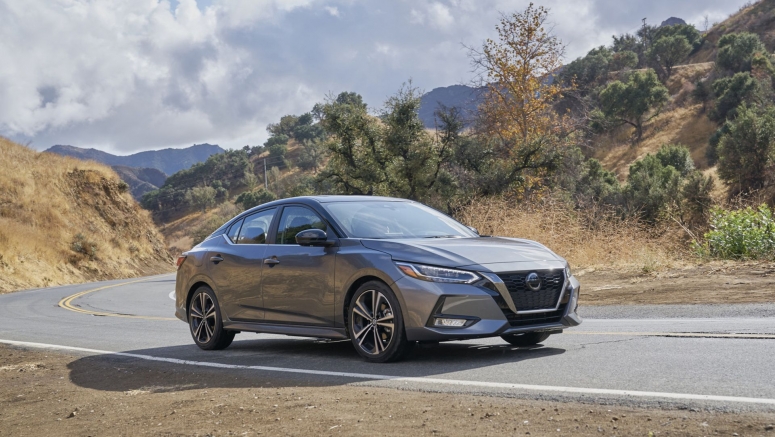2020 Nissan Sentra Review | Price, Specs, Features And Photos

The all-new 2020 Nissan Sentra compact sedan is a more competitive entry into an already competitive but shrinking car segment. This new generation of Sentra improves over the past model in many ways: Exterior styling, interior design and materials, comfort, performance and handling. We like the way it looks, and appreciate the improvements to the driving dynamics without sacrificing comfort or fuel economy.
The 2020 Sentra is a much more interesting car than generations past and a generally good offering, but it still has some flaws — meager power, a sole CVT transmission option and a cramped back seat. It's also up against some stiff competition, including the Honda Civic, Mazda3 and newly improved Toyota Corolla, which, frankly, we still prefer over the Nissan. Nevertheless, the Sentra feels competitive and well-rounded for the segment — something we wouldn't have said about it a year ago.
The Nissan Sentra is an all-new model for 2020. That means new looks, new dimensions, new interior design and materials, new driving dynamics and new performance specs.
The 2020 Sentra’s interior is an improvement from the previous version, with more inspired design and better materials that give it an altogether more upmarket and sportier feel than before. It's now one of the more handsome and well-made cabins in the segment. A lower driver’s seat with more aggressive bolstering makes it more driver-focused. We like the mix of materials on offer — which can be complemented by contrasting stitching and orange or charcoal accents — instead of vast, drab swaths of plastic. There are cloth upholstery options, as well as a leatherette and even a tan leather option with quilted stitching. Heated seats and steering wheel are also available.
A 7-inch touchscreen is standard equipment in the S trim, while the SV and SR have 8-inch units. Thankfully, there are still hard buttons for the important audio and HVAC functions, and all come with Apple CarPlay and Android Auto as standard. In addition to two standard USB ports (one front, one rear), the SV and SL trims gain a USB-C port as well. It still has analog gauges, with a digital information display in the center of the instrument panel. It offers available adaptive cruise control, and can be had with the ultra-helpful "Around View" 360-degree parking camera.
The 2020 Sentra's exterior is very close in size to its primary competitors, but it differs a little bit inside. Despite Sentra getting a slightly larger back seat for 2020, headroom is scarce, and legroom (34.7 inches) is about the same as Toyota Corolla, but falls shy of the Hyundai Elantra’s 37.3 or Honda Civic’s 37.4 inches. As a result, those rivals provide a more comfortable experience for rear passengers on longer rides or stand a better chance of accepting child seats without impinging upon front seat space.
The Sentra’s trunk has shrunk slightly for 2020, dropping down to 14.3 cubic feet from 15.1. That's still plenty big, though, as it's 1 cube bigger than the Corolla's trunk and about the same as the Elantra's. There's plenty of room for a decent grocery haul or squeezing a few small to medium roller bags inside, with a wide opening to make loading and unloading easy. A standard 60/40-split folding rear seat will help you fit larger items when you need to.
The Sentra’s sole engine offering is a naturally-aspirated 2.0-liter four-cylinder with 149 horsepower and 146 pound-feet of torque. That’s one of the lower amounts of power for the segment and it shows in 0-60 times reportedly in the 9-second range. Rivals can be 1 to 2 seconds quicker, which is a difference you'll definitely notice. The manual transmission offering is no more, and the Sentra can only be had with a continuously variable transmission (CVT).
Depending on trim level, the Sentra offers 28-29 mpg city, 37-39 mpg highway and 32-33 combined. That’s the same combined fuel economy as the standard Corolla, on the low end of the Civic’s 32-36 mpg, and slightly less than the Elantra’s 34-35 mpg. It’s not a difference you’d notice over the course of a couple days of driving. If you want high efficiency in this segment, though, there are hybrids, like the Corolla, that provide better than 50 mpg combined.
For the segment, and especially compared to the last generation, the new Sentra feels sporty. Its aggressive chassis tuning will surprise some, with a firm ride and minimal roll. It feels stable in corners thanks to a wide stance and low center of gravity. In short, it’s refined and quiet inside, but not overly isolating.
The 2.0-liter engine is smoother than the outgoing 1.8-liter, provides good mid-range power and the throttle has been programmed to be responsive. All of this results in a compact car that feels reasonably quick around town, but when merging onto the highway, the Sentra's lack of guts quickly reveals the truth: this is a slow car. The CVT probably helps wring out those meager horses a bit, but in terms of the driving experience, its simulated gear shifts can feel poorly timed. There's at least a sport mode that can make the Sentra feel more responsive and engaging.
Our first time behind the wheel of the all-new Nissan Sentra, where we find it much improved in terms of styling, interior, driving dynamics and performance: "For those that do decide that a sedan is right for them, the new 2020 Nissan Sentra is worth checking out. It’s undeniable proof that Nissan can still build an appealing small car when it wants to."



























